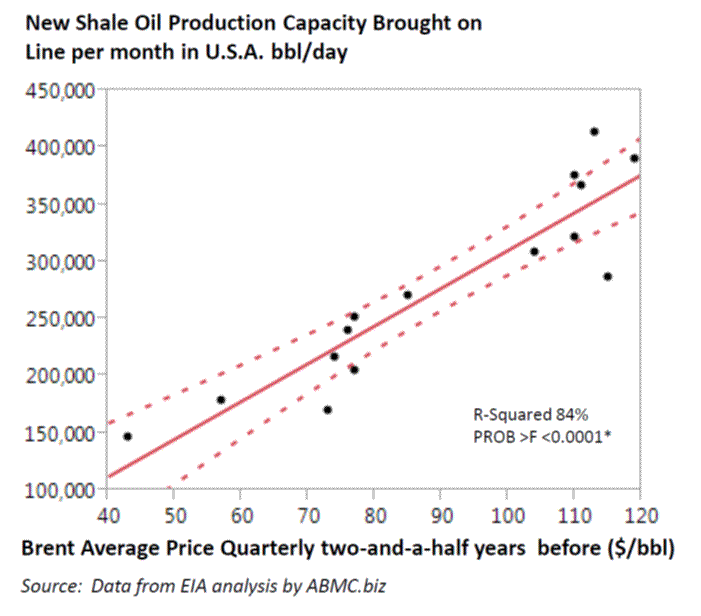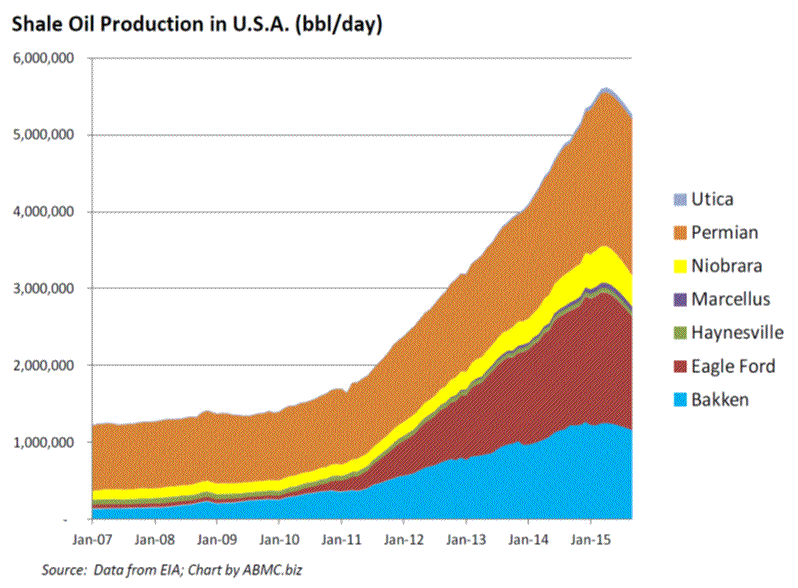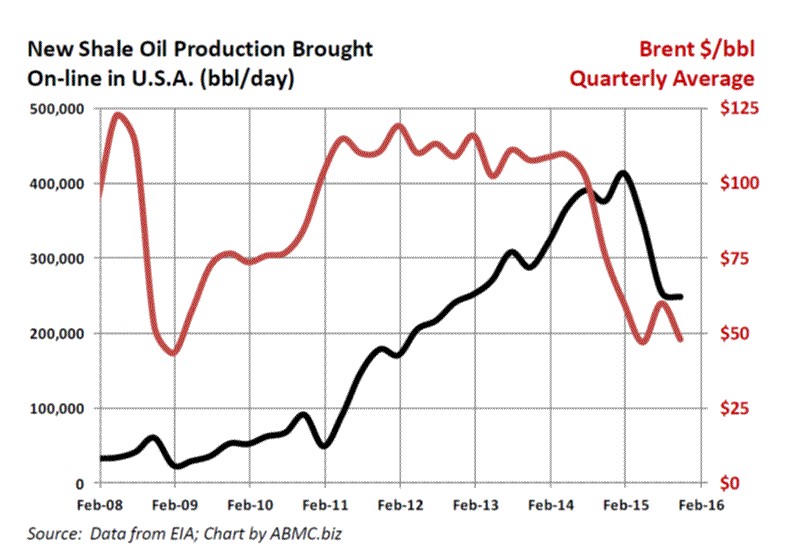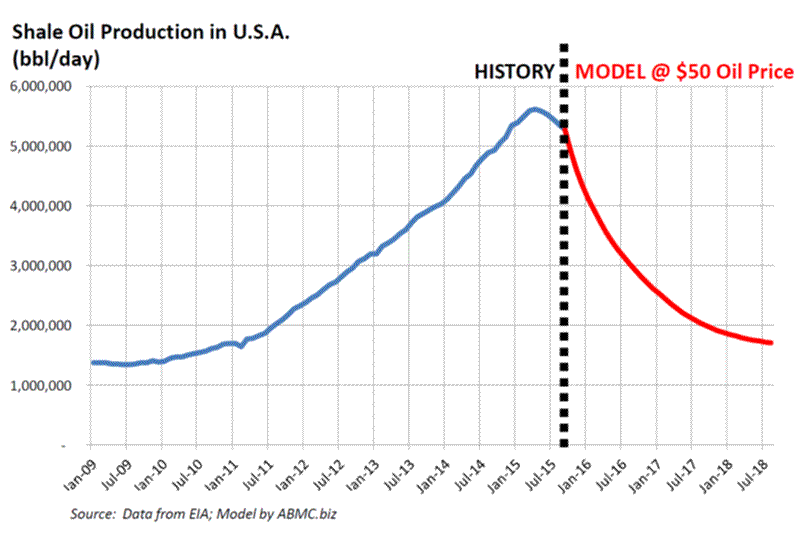The Oil Bubble...Which Just Bust...Was Caused by Derivatives: That’s why Shale Oil is finished
Commodities / Shale Oil and Gas Aug 21, 2015 - 12:34 PM GMTBy: Andrew_Butter
 There are plenty of reasons put-forward for why oil prices more than halved over the past year. But no one’s talking about a bubble that bust; seems like the world is wallowing in denial. Likely because if indeed it was a bubble (that just bust), it’s going to be a LONG TIME before anyone sees $100 again, and just about everybody has exposure to that scenario.
There are plenty of reasons put-forward for why oil prices more than halved over the past year. But no one’s talking about a bubble that bust; seems like the world is wallowing in denial. Likely because if indeed it was a bubble (that just bust), it’s going to be a LONG TIME before anyone sees $100 again, and just about everybody has exposure to that scenario.
”I Blame it on the Saudi’s...BOMB THEM” says Donald Trump, well actually he didn’t say that; but that’s the sort of stupid remark you’d expect from a Republican Party Presidential front-runner.
On a Google Search I found ONE reference to the idea it might have been a bubble (that bust). In January David Rosenburg wrote...“with perfect hindsight, oil was in a classic bubble”.
http://www.businessinsider.com/oil-and-other-bubbles-2015-1#ixzz3jKEqn59P
Ah-ha! “Might”... “Perfect Hindsight”, sounds like a hedge.
Bubbles do happen, they really do. But like sex in Victorian times, no one wants to talk about it.
I suspect, even today...with the benefit of hindsight, Ben Bernanke might reluctantly concede that it is not totally inconceivable that what happened to house prices in U.S.A. between 2004 and 2007 could...perhaps (and of course perhaps not)...have been a bubble. But perhaps he would chose to not mention the “B-Word” in polite company; certainly he’s never come out and said that explicitly, so I’m speculating.
A bubble is when price gets distorted up above what is sustainable for end-users. In the case of houses people who live in houses are the end-users. As opposed to flippers or buyers of AAA Residential Mortgage Backed Securities, who in the end, after the (alleged) bubble in house prices, bust, became proud owners of millions of house they didn’t want to live in. In the case of oil, it’s the people who use it to create value, for themselves, or value they can sell on; that are the end users.
A common cause of bubbles is when protection is sold.
The root cause of the housing bubble was AIG selling Collateral Debt Obligations (CDO’s), for pennies. Strip away the complications of the food-chain, those guaranteed that house prices would not go down (or if they did AIG would pay the difference). In other words, they arbitrarily set a price for the future. So why would anyone sell a house for less than what AIG guaranteed it would be worth in the future? Instead of selling the house for less, all you had to do was to wait for the future and AIG would buy it from you, unless in the mean-time you got a matching or better offer from someone who actually fancied living in the house.
The “market” was no longer people who wanted to buy houses to live in them; it was some genius in AIG with a theory risking other people’s money, well actually the way it turned out, it was the government’s money (money it didn’t have incidentally). And of course, because AIG was writing guarantees, the banks were happy to lend because the deal had no risk...or so they thought.
The cause of the recent bubble in oil prices was protection sold on shale oil production.
Just like in the case of the housing bubble (if that’s what it was); the culprit was the un-regulated derivatives market. Yes there is a market for oil futures, but that’s expensive, it’s much cheaper (and often much more profitable) to find a genius to write a derivative and keep it in a draw, preferably “off-balance-sheet”. No one knows what the exposure on production hedges for shale oil is; no one knows who has the exposure. Yes there are guesses, anywhere between $26 Billion (peanuts), to a “several trillions”.
But no one is talking...”Brooksley Born...WHERE WERE YOU WHEN WE NEEDED YOU?”
Hedging oil “production” risk is a new thing. They should call it “market” risk but that might give the game away. The regulated futures market is populated on one side by end-users who want to lock in their future cost of buying oil, with the counter-parties being gamblers who want to take on that risk. There’s nothing wrong with that, the market is transparent, and regulated.
For conventional oil, the market (production) risk cannot be hedged, it’s too far in the future so it’s too expensive to do that (and risky); but the life-cycle of a shale-oil well is so short that the market risk can be hedged, particularly if you can find a genius to write a derivative.
Almost all of the first two years of production of every shale-oil well in U.S.A. was 100% hedged (two years is about what you need to get payback), and because it was hedged (no risk) almost all of the cost of development was financed with debt. So some genius writes a derivative that says he will buy oil at $100 a barrel in two years time, he has a theory. Once he did that, and the word got around, who would want to sell oil for less than $100 minus the cost of storage and financing at ZIRP? Answer...no one; so the price was no longer dictated by willing buyers negotiating with willing sellers, it was set by the genius with a theory and a bankroll, back-stopped by the knowledge of “Too Big to Fail.”
Sounds familiar?
This is a chart of the new production of shale oil brought on line in USA, compared to the price of oil two and a half years earlier, which is about the time it takes to buy the acreage, drill the hole, do the hydraulic fracturing, and then open the tap.

Looks suspiciously like the geniuses writing the derivatives looked at the oil price at the time, and said “OK, pay me a premium every month and I’ll guarantee you get that price when you bring the oil in; less 10%...20%...whatever”.
And so that set the minimum for the future. But when there is a minimum, the real-live traders dealing with real-live end-users; hold out for more, so the price edges up, so does the minimum.
So when does it stop?
Simple; that happens when geniuses run out of suckers willing to put their money at risk based on a theory, like the one...”house-prices-never-go-down”. It’s tough to figure when the world will run out of suckers; certainly I got that wrong in 2012.
http://www.marketoracle.co.uk/Article34980.html
I was sure that even the pension funds who lost a bundle buying AAA cans of worms from God’s Workers...who incidentally were batting for the other side also...so buyers were “double-suckers”...and on top of that many of them didn’t speak good enough English to understand what the words “non-recourse” meant...might have been “once-bitten-twice-shy”. And might have realized that for anyone who doesn’t do a line of cocaine for breakfast (apparently a lot of geniuses on Wall Street do that), $100 Brent (or more) had to be a bubble.
Even the Saudi’s said it was a bubble. They should know, all they did for the past fifty years, is sell oil. Don’t the counterparties on the genius’ trades...read...anything? In the event, it took three years to run out of counterparties willing to bankroll the geniuses writing the un-regulated derivatives.
Meanwhile:

That’s a lot of oil; it peaked at 5.6 million barrels a day in April 2015. By way of a benchmark, today Saudi Arabia is pumping 10.3 million barrels a day; Iran is pumping about 3.6 million. In November 2014 OPEC was suggesting cutting two-million barrels a day so as to “stabilize” prices; and the Saudi’s decided not to play ball; two million barrels per day is about how much extra capacity the U.S. Oil-Shale industry brought on line in the past two years.
And you wonder why...when the geniuses ran out of counter-parties, or perhaps they were finally told by “those-jerks” in compliance, to stop writing derivatives that the shale-oil drillers could use to get “risk-free” financing...the oil-price tanked?
What Next?
The loss of legacy production in U.S. Shale Oil fields currently averages about 8% of the current production. Keeping up production is all about drilling new wells.
Since the crash, after a lag of about six months, during which time the news sank in and also the projects that were ongoing, got finished, New Production dropped from a peak of 485,000 bbl/day, brought on line in December 2014, to 250,000 bbl/day in July 2015...i.e. it was cut about in half.

The drillers are saying that now it costs much less to develop shale oil than it did five-years ago, that’s probably right, technology advanced, and also, right now with so many rigs laid off, the day-rates are through the floor. All the same, it’s likely that the holes drilled five years ago, were the low-hanging fruit. So perhaps the brave sound-bites are more about reassuring investors and bankers?
Either way, it’s hard to hard to guess where the new production figure will end up. In 2010 when oil was $75 (Brent) new production was less than 1000,000 barrels per day; then the oil price climbed, and everything started to take off. My guess is that if oil stays around $50 in the foreseeable future, new production could fall back to 100,000 barrels per day per month.
This is a model for the production of shale oil in U.S.A. going forwards...if the price of oil stays around $50 in the medium-term.
According to BUBBLEOMIX $50 is the most likely scenario, but if you don’t buy that Mumbo-Jumbo, it may be worth remarking that currently the futures markets (the regulated ones), are selling oil for delivery in 2020 at $62 (or so). Those prices are put out by real live traders, dealing with real-live end-users, and not a derivative in sight.

There you have it, the shale oil drillers are the new swing producers.
Looks like by July 2017 they will have taken enough oil off the table to allow the price to start moving up to about $75, at which point geniuses writing un-regulated derivatives hedging production, might become flavor of the month yet again.
Notes:
Previous posts implicitly and explicitly referenced in this post include:
Crude Oil Ten-Year Price Forecast to 2025 (Jan 2015):
http://www.marketoracle.co.uk/Article48969.html
U.S. Shale Oil is the New Swing Producer (Dec 2014):
http://www.marketoracle.co.uk/Article48439.html
Reasons Saudi Will Not Swing (Nov 2014):
http://www.marketoracle.co.uk/Article48331.html
When (Not IF) Crude Oil drops below $70 (Oct 2014):
http://www.marketoracle.co.uk/Article47786.html
Will the Oil Bubble Pop Down to $67 (Jun 2012):
http://www.marketoracle.co.uk/Article34980.html
By Andrew Butter
Twenty years doing market analysis and valuations for investors in the Middle East, USA, and Europe. Ex-Toxic-Asset assembly-line worker; lives in Dubai.
© 2015 Copyright Andrew Butter- All Rights Reserved
Disclaimer: The above is a matter of opinion provided for general information purposes only and is not intended as investment advice. Information and analysis above are derived from sources and utilising methods believed to be reliable, but we cannot accept responsibility for any losses you may incur as a result of this analysis. Individuals should consult with their personal financial advisors.
Andrew Butter Archive |
© 2005-2022 http://www.MarketOracle.co.uk - The Market Oracle is a FREE Daily Financial Markets Analysis & Forecasting online publication.



